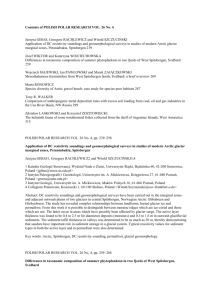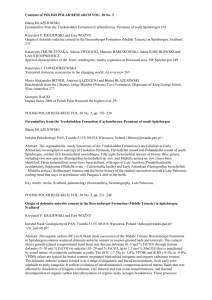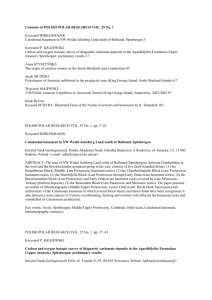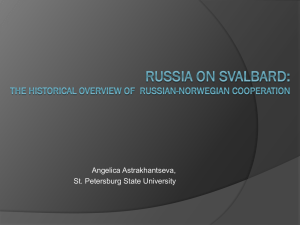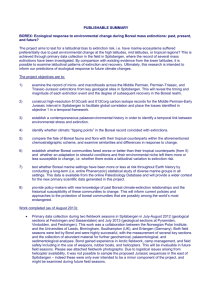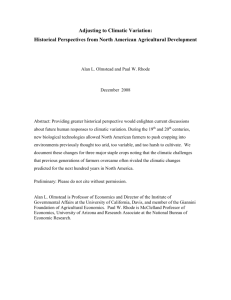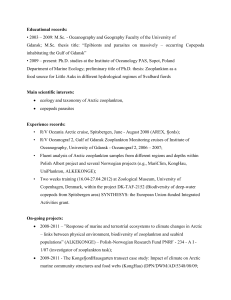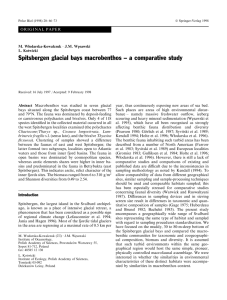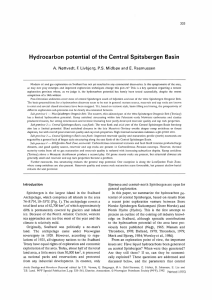POLISH POLAR RESEARCH VOL
advertisement
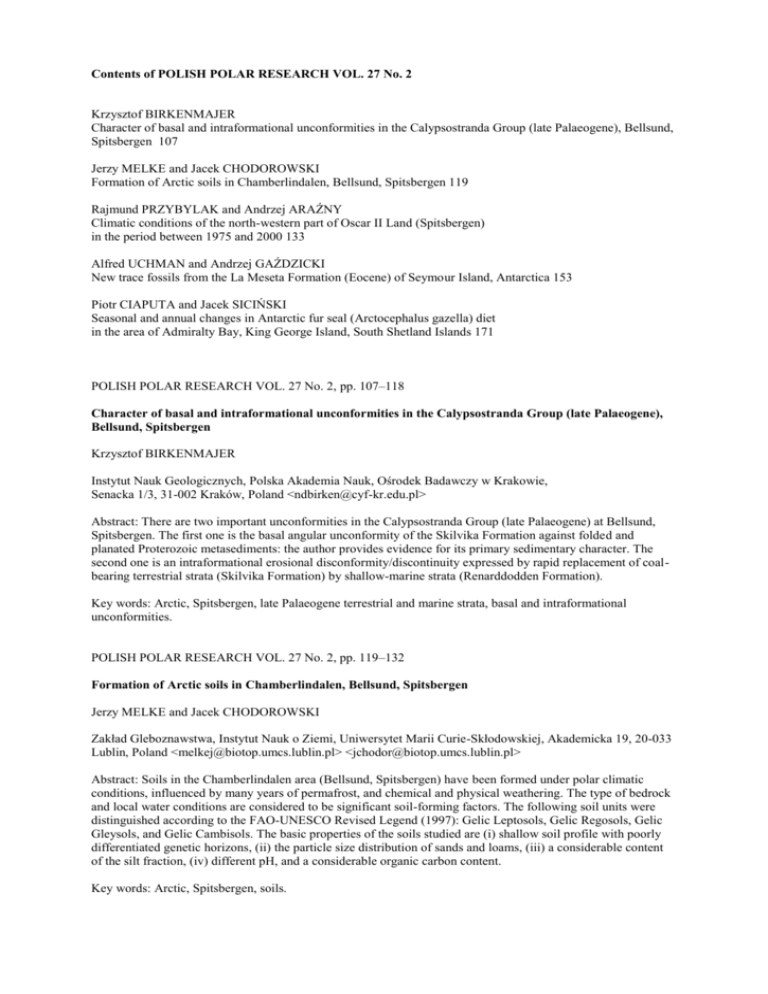
Contents of POLISH POLAR RESEARCH VOL. 27 No. 2 Krzysztof BIRKENMAJER Character of basal and intraformational unconformities in the Calypsostranda Group (late Palaeogene), Bellsund, Spitsbergen 107 Jerzy MELKE and Jacek CHODOROWSKI Formation of Arctic soils in Chamberlindalen, Bellsund, Spitsbergen 119 Rajmund PRZYBYLAK and Andrzej ARAŹNY Climatic conditions of the north-western part of Oscar II Land (Spitsbergen) in the period between 1975 and 2000 133 Alfred UCHMAN and Andrzej GAŹDZICKI New trace fossils from the La Meseta Formation (Eocene) of Seymour Island, Antarctica 153 Piotr CIAPUTA and Jacek SICIŃSKI Seasonal and annual changes in Antarctic fur seal (Arctocephalus gazella) diet in the area of Admiralty Bay, King George Island, South Shetland Islands 171 POLISH POLAR RESEARCH VOL. 27 No. 2, pp. 107–118 Character of basal and intraformational unconformities in the Calypsostranda Group (late Palaeogene), Bellsund, Spitsbergen Krzysztof BIRKENMAJER Instytut Nauk Geologicznych, Polska Akademia Nauk, Ośrodek Badawczy w Krakowie, Senacka 1/3, 31-002 Kraków, Poland <ndbirken@cyf-kr.edu.pl> Abstract: There are two important unconformities in the Calypsostranda Group (late Palaeogene) at Bellsund, Spitsbergen. The first one is the basal angular unconformity of the Skilvika Formation against folded and planated Proterozoic metasediments: the author provides evidence for its primary sedimentary character. The second one is an intraformational erosional disconformity/discontinuity expressed by rapid replacement of coalbearing terrestrial strata (Skilvika Formation) by shallow-marine strata (Renarddodden Formation). Key words: Arctic, Spitsbergen, late Palaeogene terrestrial and marine strata, basal and intraformational unconformities. POLISH POLAR RESEARCH VOL. 27 No. 2, pp. 119–132 Formation of Arctic soils in Chamberlindalen, Bellsund, Spitsbergen Jerzy MELKE and Jacek CHODOROWSKI Zakład Gleboznawstwa, Instytut Nauk o Ziemi, Uniwersytet Marii Curie-Skłodowskiej, Akademicka 19, 20-033 Lublin, Poland <melkej@biotop.umcs.lublin.pl> <jchodor@biotop.umcs.lublin.pl> Abstract: Soils in the Chamberlindalen area (Bellsund, Spitsbergen) have been formed under polar climatic conditions, influenced by many years of permafrost, and chemical and physical weathering. The type of bedrock and local water conditions are considered to be significant soil-forming factors. The following soil units were distinguished according to the FAO-UNESCO Revised Legend (1997): Gelic Leptosols, Gelic Regosols, Gelic Gleysols, and Gelic Cambisols. The basic properties of the soils studied are (i) shallow soil profile with poorly differentiated genetic horizons, (ii) the particle size distribution of sands and loams, (iii) a considerable content of the silt fraction, (iv) different pH, and a considerable organic carbon content. Key words: Arctic, Spitsbergen, soils. POLISH POLAR RESEARCH VOL. 27 No. 2, pp. 133–152 Climatic conditions of the north-western part of Oscar II Land (Spitsbergen) in the period between 1975 and 2000 Rajmund PRZYBYLAK and Andrzej ARAŹNY Uniwersytet Mikołaja Kopernika, Instytut Geografii, Zakład Klimatologii, Danielewskiego 6, 87-100 Toruń, Poland <rp11@geo.uni.torun.pl> Abstract: The paper describes climatic conditions of the north-western part of Oscar II Land (Spitsbergen) based on meteorological data from 1975 to 2000, which were taken from Ny Ĺlesund and Kaffiöyra-Heggodden stations. The changes in annual courses of main climatic elements are investigated. However, the authors focused mainly on the analysis of summer climate, because most of the field work is conducted at this time of the year. Aside from the standard climatic analysis, the influence of atmospheric circulation on selected meteorological elements was also investigated. The climate of the north-western part of Oscar II Land was compared with the climates of the remaining areas of the western coast of Spitsbergen. It was found that the climate of the studied area differs considerably from the climate of the central-inner and southern parts of the western coast of Spitsbergen (areas represented by the Svalbard Lufthavn and Hornsund stations respectively). The differences in climatic elements, however, are not stable throughout the year and in particular seasons and months can even change signs. Thus, any generalisation of results obtained based on seasonal data is inadmissible. It was also found that the wind conditions of the Kaffiöyra region are more representative of the north-western part of Oscar II Land than are the wind conditions of the Ny Ĺlesund region. Key words: Arctic, Spitsbergen, Oscar II Land (Kaffiöyra), climate. POLISH POLAR RESEARCH VOL. 27 No. 2, pp. 153–170 New trace fossils from the La Meseta Formation (Eocene) of Seymour Island, Antarctica Alfred UCHMAN1 and Andrzej GAŹDZICKI2 1 Instytut Nauk Geologicznych, Uniwersytet Jagielloński, Oleandry 2a, 30-063 Kraków, Poland <fred@geos.ing.uj.edu.pl> 2 Instytut Paleobiologii, Polska Akademia Nauk, Twarda 51/55, 00-818 Warszawa, Poland <gazdzick@twarda.pan.pl> Abstract: Trace fossils Lockeia siliquaria James, Ophiomorpha nodosa Lundgren, Parataenidium seymourensis isp. n., Protovirgularia rugosa (Miller and Dyer) and Rhizocorallium jenense Zenker have been described for the first time from the Eocene La Meseta Formation of Seymour (Marambio) Island, Antarctic Peninsula. Determinations of some trace fossils formerly described from this formation have been revised. The whole trace fossils association from the La Meseta Formation points to foreshore-offshore environment as indicated by presence of the Skolithos and Cruziana ichnofacies, and to at least temporal normal salinity. Key words: Antarctica, Eocene, trace fossils. POLISH POLAR RESEARCH VOL. 27 No. 2, pp. 171–184 Seasonal and annual changes in Antarctic fur seal (Arctocephalus gazella) diet in the area of Admiralty Bay, King George Island, South Shetland Islands Piotr CIAPUTA1 and Jacek SICIŃSKI2 1 Zakład Biologii Antarktyki, Polska Akademia Nauk, Ustrzycka 10, 02-141 Warszawa, Poland <p.ciaputa@poczta.onet.pl> 2 Zakład Biologii Polarnej i Oceanobiologii, Uniwersytet Łódzki, Banacha 12/16, 90-237 Łódź, Poland <sicinski@biol.uni.lodz.pl> Abstract: This study describes the seasonal and annual changes in the diet of non-breeding male Antarctic fur seals (Arctocephalus gazella) through the analysis of faeces collected on shore during four summer seasons (1993/94–1996/97) in the area of Admiralty Bay (King George Island, South Shetlands). Krill was the most frequent prey, found in 88.3% of the 473 samples. Fish was present in 84.7% of the samples, cephalopods and penguins in 12.5% each. Of the 3832 isolated otoliths, 3737 were identified as belonging to 17 fish species. The most numerous species were: Gymnoscopelus nicholsi, Electrona antarctica, Chionodraco rastrospinosus, Pleuragramma antarcticum, and Notolepis coatsi. In January, almost exclusively, were taken pelagic Myctophidae constituting up to 90% of the total consumed fish biomass. However, in February and March, the number of bentho-pelagic Channichthyidae and Nototheniidae as well as pelagic Paralepididae increased significantly, up to 45% of the biomass. In April the biomass of Myctophidae increased again. The frequency of squid and penguin occurrence was similar and low, but considering the greater individual body mass of penguins, their role as a food item may be much greater. In March and April, penguins could be as important prey item as fish. The amount of krill in the diet of Antarctic fur seals declined with a concomitant decrease in the mature krill availability. This appears to have been compensated by an increased frequency of the fur seal to eat fish and penguins. Key words: Antarctica, Admiralty Bay, Antarctic fur seal, diet.
